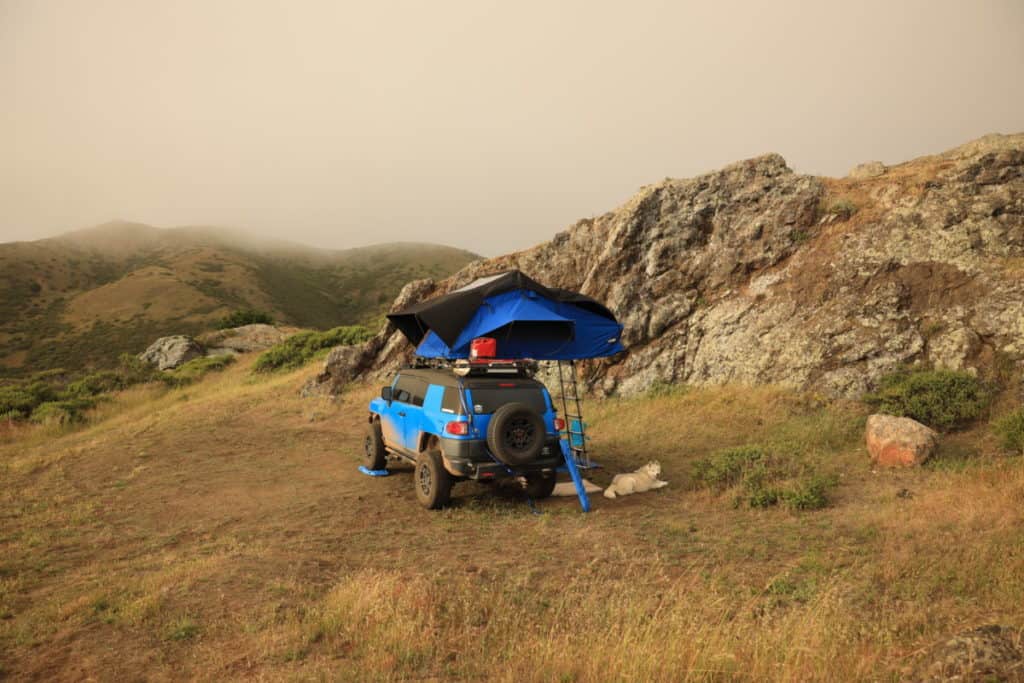
When condensation builds up on and in your roof top tent, it can be very frustrating to deal with. Obviously, you would like to stay dry throughout the night. But also, once you wake up in the morning you don’t want your tent to be covered in water.
If you go to pack up the tent when there is still moisture inside of it or under the mattress, you will have to open it once you’re home and let it air out to avoid mildew.
The best way to stop condensation in a roof top tent is by adding an anti-condensation mat, properly ventilating it, and also adding a fan to assist with air circulation.
These are what I have found to be the most effective solutions to this common issue. Now that we have identified what works, let’s talk a little bit about each solution and how you can implement it!
Anti-condensation Mat
RTT manufacturers quickly realized that condensation build-up was a major issue for many campers. They remedied this problem by making a mat that will help absorb and reduce the moisture created inside your tent.
This is achieved by allowing more air to flow between the mattress and base of the RTT. A fair amount of four-season RTTs come with one included, but manufacturers often offer aftermarket upgrades that will fit your model perfectly.
One of these mats will cost you roughly $100 – $150 dollars. Even if your specific tent manufacturer doesn’t offer one, you can buy this anti-condensation mat which I highly recommend! There are a few different sizes and one of them will likely be very close to the dimensions of your particular RTT!
Apply carpet tile to the base
A cheaper but far more labor-intensive solution to reducing condensation is to apply carpet tiles instead of an anti-condensation mat.
I want to give credit for the idea to this guy’s channel on Youtube which is very helpful. He goes all the way through the process from start to finish which will allow you to see what you’d be getting yourself into!
Personally, I would just go ahead with buying an anti-condensation mat. But if you’re on a budget or are more of a DIY type of guy or gal, this is a very doable project!
The fact is that adding these carpeted tiles will help absorb the condensation that forms between your mattress and tents metal base. I think it is a very creative solution and would be interested to see its effectiveness compared to an actually anti-condensation mat.
Ventilating your tent is key
RTTs already have the advantage of being off the ground and not sitting on a wet or damp surface. That said, you will still notice condensation in humid or cold climates.
The completely free thing you can do to preventing condensation from building up on your RTT is to simply keep it ventilated by opening multiple windows. Allowing air to circulate through your tent before, during, and after you sleep inside the tent will make a world of difference!
Even if I think my tent won’t collect any condensation, I cautiously keep the windows open and the mosquito nets closed! You can also buy a cheap, or expensive, rechargeable fan to run throughout the night and assist with air circulation!
Check out our Recommended Gear page for our favorite heater and other camping accessories!
When I was younger, I remember waking up in the morning while camping and noticing my left arm was soaked because I was sleeping against one of the edges of the tent. I didn’t know it at the time, but it was because we didn’t ventilate the tent at all. If you’re camping in colder temperatures, I would recommend bundling up because you still need air to circulate into the RTT.
While simple, this is by far the most important step you need to take when looking to stop condensation!
General tips to keep your RTT dry
There are also some general points of camping adequate to know if you want to avoid condensation!
First, while we are all guilty of wanting to sleep near a water source; whether it be a lake, pond, river, or even the ocean, humidity is much higher in these areas so steer clear if you think condensation will be an issue.
Next, keep all of your wet belongings such as shoes, clothes, or towels! The name of the game is to eliminate all possible sources of added moisture from the equation.
If you know it won’t rain during your camping trip, remove the rainfly. Oftentimes, the rainfly is a magnet for collecting condensation between it and the roof of your tent!
What are the best roof top tents to stop condensation?
You want to find a RTT that has one of these features or more! An anti-condensation mat, large windows to help with ventilation, foam cell wall, built-in fan, a breathable fabric, and or an inner-liner.
I think just having a couple of these features would be more than enough to fend off condensation.
The iKamper RTT line features premium materials from top to bottom. One material in particular benefits from this quality, the fabric. Their fabric allows the tent to “breathe”, which helps better circulate your tent even if you don’t open any windows!
I know that the Tepui Ruggedized Series comes with a half-inch anti-condensation mat and a thick 360-gram fabric. While CVT, a premium RTT brand, has its Summit and hybrid edition tents which also comes with an anti-condensation mat!
James Baroud is a pillar in the RTT industry and they actually have solar-powered fans which are designed to circulate air throughout the tent. These fans are seamlessly fitted within the tents and can run for 24 hours off of a single charge!
The Alu-Cab Gen 3 has a foam cell wall that helps with insulation and can absorb moisture as well. This is a pretty unique feature, but it’s not surprising coming from a top of the line RTT.
Last but not least, the FSR High Country features a tri-layer technology. This is great for four-season camping, but also keeps condensation from building up inside the tent walls!
Each of these tents has a solid feature that will reduce condensation. Which is most important is hard to say.
Wrapping Up
Minimizing the amount of condensation that builds up in and on your tent comes down to a culmination of factors. If you were to implement each or at least some of these tips, you will see a noticeable difference in the amount of water accumulating throughout the night.
At some point, most RTT owners will come across this problem and it is best to fix the problem rather than run this risk of packing your tent up when damp.
Whether you go with an expensive solution, a DIY build, or simply take the small and simple steps, each will have positive affect in fighting against condensation!
It also depends on the severity of where you live and decide to go camping. Someone living in the desert is better off than a camper right near the equator! Gage the problem based on your situation and you will be able to find the perfect remedy to your situation.
